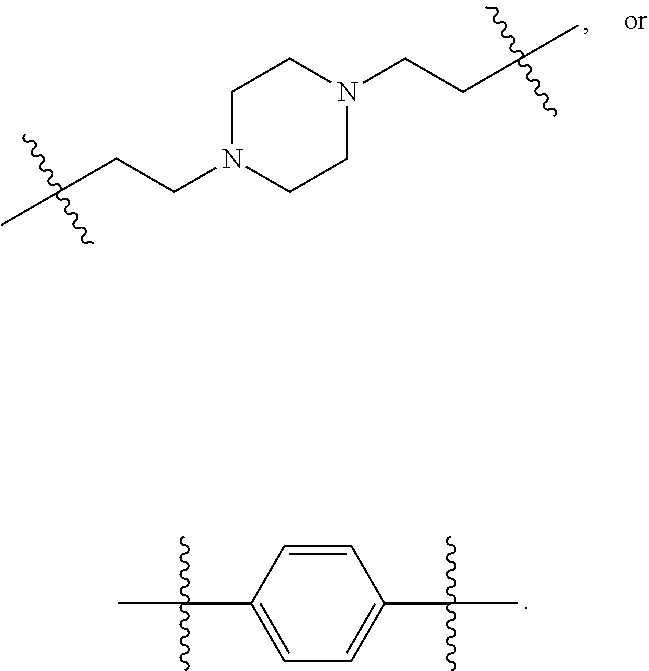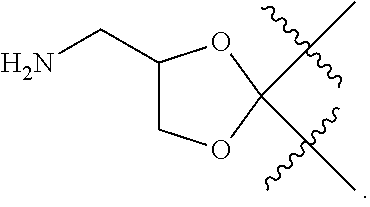Novel agents for reworkable epoxy resins
a technology of epoxy resin and reworkability, which is applied in the field of thermosetting polymers, can solve the problems of inability to melt and rework the material without decomposition, difficult removal, recycling and reworkability, and difficult cure of anhydride epoxy formulations at room temperature, and achieves the effect of rapid disassembly
- Summary
- Abstract
- Description
- Claims
- Application Information
AI Technical Summary
Benefits of technology
Problems solved by technology
Method used
Image
Examples
example 1
Synthesis of Amino Ketal
[0086]
[0087]N-(6-hydroxyhexyl)pthalimide (50 g, 202 mmol), 2,2-dimethoxypropane (21 g, 202 mmol), and a catalytic amount of p-toluene sulfonic acid monohydrate (192.3 mg, 1 mmol, 0.005 equiv.) were placed in 200 mL of toluene in a 500 mL Round Bottom Flask equipped with a 25 mL Dean Stark apparatus. The reaction was heated to reflux and the Dean Stark column emptied every 5 hours. After 20 hours, the reaction mixture was cooled to ambient temperature and concentrated under reduced pressure. The resulting crude residue was dissolved in 50 mL of THF and then 80% hydrazine hydrate (80 g, 1280 mmol) was added and the reaction mixture was heated to reflux again. After 10 hours, the reaction was cooled to room temperature, filtered and concentrated under reduced pressure. The resulting crude oil was dissolved in dichloromethane, the solution washed with water and brine, dried with Na2SO4, and then concentrated under reduced pressure to give 20 g of the title compou...
example 2
Synthesis of Amino Orthoesters
[0089]
[0090]N-(6-hydroxyhexyl)pthalimide (140 g, 567 mmol), triethyl orthoacetate (31 g, 195 mmol), and a catalytic amount of p-toluene sulfonic acid monohydrate (31.9 mg, 0.168 mmol, 0.0009 equiv.) were placed in 700 mL of cyclohexane. The reaction mix was heated to reflux and the evolved ethanol removed via distillation of the cyclohexane / ethanol azeotrope (vapor temperature 60-80.5 ° C.). After the reaction vapor temperature reached 80.5 ° C., the reaction mixture was heated for additional 30 minutes. Subsequently, the solution was cooled to ambient temperature and the solvent removed under reduced pressure. The resulting crude residue was dissolved in 800 mL of THF and then 80% hydrazine hydrate (222.3 g, 3.8 mol) was added and the reaction heated to reflux. After 10 hours, the reaction was cooled to room temperature, filtered, and concentrated under reduced pressure. The resulting crude oil was dissolved in dichloromethane, the solution washed with...
example 3
Synthesis of Amino Orthocarbonates
[0092]
[0093]N-(6-hydroxyhexyl)pthalimide (20 g, 80.8 mmol), tetraethyl orthocarbonate (4.13 g, 20 mmol), and a catalytic amount of p-toluene sulfonic acid monohydrate (3.4 mg, 0.0179 mmol, 0.0009 equiv.) were placed in 100 mL of cyclohexane. The reaction mix was heated to reflux and the evolved ethanol removed via distillation of the cyclohexane / ethanol azeotrope (vapor temperature 60 ° C.). After the reaction vapor temperature reached 80.5 C, the reaction was heated for an additional 30 min. Subsequently, the solution was cooled to ambient temperature and the solvent removed under reduced pressure. The resulting crude residue was dissolved in 50 mL of THF and then 80% hydrazine hydrate (36 g, 576 mmol) was added and the reaction heated to reflux. After 10 hours, the reaction was cooled to room temperature, filtered, and concentrated under reduced pressure. The resulting crude oil was dissolved in dichloromethane, the solution washed with water and ...
PUM
| Property | Measurement | Unit |
|---|---|---|
| temperature | aaaaa | aaaaa |
| vapor temperature | aaaaa | aaaaa |
| temperature | aaaaa | aaaaa |
Abstract
Description
Claims
Application Information
 Login to View More
Login to View More - R&D
- Intellectual Property
- Life Sciences
- Materials
- Tech Scout
- Unparalleled Data Quality
- Higher Quality Content
- 60% Fewer Hallucinations
Browse by: Latest US Patents, China's latest patents, Technical Efficacy Thesaurus, Application Domain, Technology Topic, Popular Technical Reports.
© 2025 PatSnap. All rights reserved.Legal|Privacy policy|Modern Slavery Act Transparency Statement|Sitemap|About US| Contact US: help@patsnap.com



